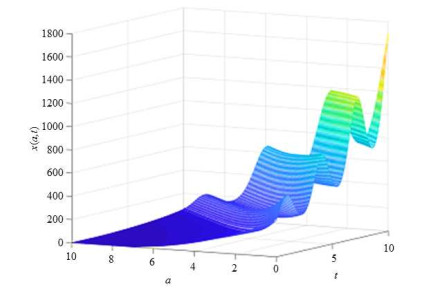1 引言
文献[1]对一类非线性年龄结构模型提出迎风差分近似算法,模型带有广泛的边界条件.运用抽象离散化理论分析了算法的一致性、稳定性与收敛性.文献[2]对同一模型给出盒子算法,它是二阶收敛的.针对Gurtin-MacCamy模型,文献[3]设计Euler方法,但无收敛性分析.文献[4]对McKendrick类模型的最优控制问题导出HJB方程,并对作为其粘性解的值函数提出有限差分法.文献[5]对当时已有的数值方法作综述,主要包括特征线方法与有限差分法.文献[6]就线性自治年龄结构模型给出有限元方法,分析其稳定性并估计误差.基于特征线上的积分,文献[7]为一类非线性非自治系统提出了数值算法,证明其为二阶收敛的.专著[8]对年龄结构系统模型的数值解方法论和具体算法做了可读性很强的陈述.在尺度结构模型方面,文献[9]提出了求解一类随机模型反问题的计算方法,文献[10]对一类具有广泛边界条件的系统证明了解的存在性、光滑性,以及数值解法的收敛性.基于非负增长率和密度依赖的个体参数建模,文献[11]比较了Euler法、隐差分法和特征线法,指出:将特征线法与适应性格点相结合会取得更好的效果.文献[12]对含有正增长率的线性模型提出近似解法,并导出最优收敛速度.类似地,文献[13]研究各种算法的效率,比较特征线法、L-W方法与盒子法,认为盒子法所受限制虽少,但耗时较多.综述文献[14]对当时已有的尺度结构模型的近似算法作出比较和评述.针对描述Gambussia affinis种群演化模型,文献[15]介绍了四种算法,分析解的特点.文献[16]的建模考虑资源与种群的相互作用,并且尺度能收缩、最大尺度可变,文中给出了改进的Euler法.文献[17]对一类含有外界幼体投放的非线性模型设计了隐差分逼近,确立了收敛性.除了分析适定性、稳定性和最优收获问题,文献[18]也对一类尺度结构模型给出了离散化方法与算例.
基于个体等级的连续数学模型,一方面较为真实地描述了种群生态实际,另一方面也导致了较强的理论与数值分析挑战.与年龄、尺度结构模型比较,等级结构模型具有更强的非线性需要处理.适用于年龄和尺度结构模型的数值解法,都不能直接用于等级结构模型.因此,本文拟研究一类连续等级结构模型,提出它的数值解法,证明其收敛性,并给出数值算例.
2 系统模型
本文旨在研究下列非线性等级结构种群模型的数值解法:
其中
假定下述基本条件成立:
(A1)
(A2)
3 离散化方法
系统(2.1)的解在特征线
对任意给定的
为了陈述算法所需,引进下列记号:
(1) 常数
(2) 引入一个正整数
(3) 记
(4) 令
(5) 按照(4)中的记号,
利用(4)式可定义系统(2.1)的数值算法如下:对
其中
年龄等分中点处的近似值定义为:
4 收敛性分析
令步长
其中
其中第一项用于考虑初始分布的误差,第二项用于考虑边界点的误差,第三项用于考虑其它节点的误差.显然空间
为了测量误差的大小,定义如下范数:
赋予
若
令
设
等号右边的元素定义如下:
对于
其中
易知,
在下文中,
引理4.1 假设(A1)-(A4)成立,
证 由(3.6)和(3.8)式知:对于
(4.9)式得证.
同理由
当
当
由假设条件(A1)-(A4),不等式
最后,利用
定义4.1[7] 记局部离散误差为
引理4.2 若条件(A1)-(A4)成立,则当
证 记
其中
所以有
从而当
同理,当
综上,由
下面考虑
最后一步用到了
定义4.2[7] 对
则称离散化映射
引理4.3 若条件(A1)-(A4)成立,则离散化映射
证 令
当
同理,当
当
当
另一方面,当
由
由不等式
分别将(4.22), (4.23)和(4.25)式中的
运用离散化的Gronwall引理得
最后将(4.26)式带入到(4.22), (4.23)和(4.25)式中,即得引理结论.
定义4.3[7] 记全局离散误差为
那么称
下面引用文献[23]中的已知结果:
引理4.4[23] 假设
(1)
(2) 上述解收敛并且
定理4.1 假设(A1)-(A4)成立.则当
证
5 算例
例1 种群走向绝灭.选定参数:
图 1
例2 种群持续生存.选定参数:
图 2
参考文献
An upwind scheme for a nonlinear hyperbolic integro-differential equation with integral boundary condition
DOI:10.1016/0898-1221(91)90030-8 [本文引用: 2]
A box method for a nonlinear equation of population dynamics
DOI:10.1093/imanum/11.4.525 [本文引用: 1]
Numerical solution of structured population models Ⅰ. Age structure
DOI:10.1007/BF00168048 [本文引用: 1]
Numerical solution to the optimal birth feedback control of a population dynamics:viscosity solution approach
Age-structured population models and their numerical solution
DOI:10.1016/j.ecolmodel.2005.05.007 [本文引用: 1]
Age-time continuous Galerkin methods for a model of population dynamics
DOI:10.1016/j.cam.2008.02.004 [本文引用: 1]
A numerical method for nonlinear age-structured population models with finite maximum age
Computational techniques for inverse problems in size structured stochastic population models
A fully discretized approximation scheme for size-structured population models
Numerical solution of structured population models Ⅱ. Mass structure
DOI:10.1007/BF00160170 [本文引用: 1]
Numerical scheme for size-structured population equations
DOI:10.1016/S0025-5564(98)10081-0 [本文引用: 1]
Numerical integration of autonomous and non-autonomous nonlinear size-structured population models
Size-structured population dynamics models and their numerical solutions
DOI:10.3934/dcdsb.2004.4.1203 [本文引用: 1]
Numerical study of size-structured population models:A case of Gambussia affinis
DOI:10.1016/j.crvi.2004.11.007 [本文引用: 1]
Numerical approximation of singular asymptotic states for a size-structured population model with dynamical resource
DOI:10.1016/j.mcm.2010.12.006 [本文引用: 1]
An implicit finite difference scheme for the nonlinear size-structured population model
具有尺度结构和双加权的种群模型:稳定性与最优收获
A weighted population model with size-structure:Stability and optimal harvesting
A quasilinear hierarchical size-structured model:well-posedness and approximation
DOI:10.1007/s00245-004-0806-2 [本文引用: 1]
A high order WENO scheme for a hierarchical size-structured population model
DOI:10.1007/s10915-007-9152-x [本文引用: 1]
A monotone approximation for a size-structured population model with a generalized environment
DOI:10.1080/17513750701605564 [本文引用: 1]
一类非线性等级结构种群控制模型解的适定性
The well-posedness of a nonlinear hierarchical age-structured population control model
Stability and convergence in numerical analysis Ⅲ:Linear investigation of nonlinear stability
DOI:10.1093/imanum/8.1.71 [本文引用: 2]




